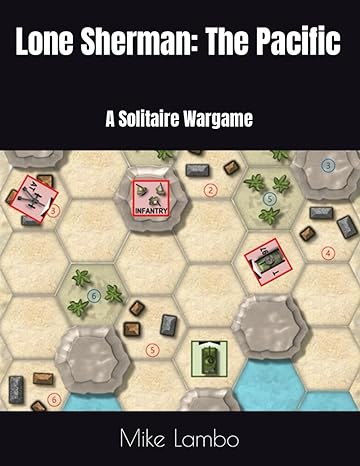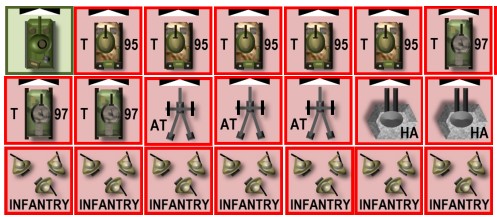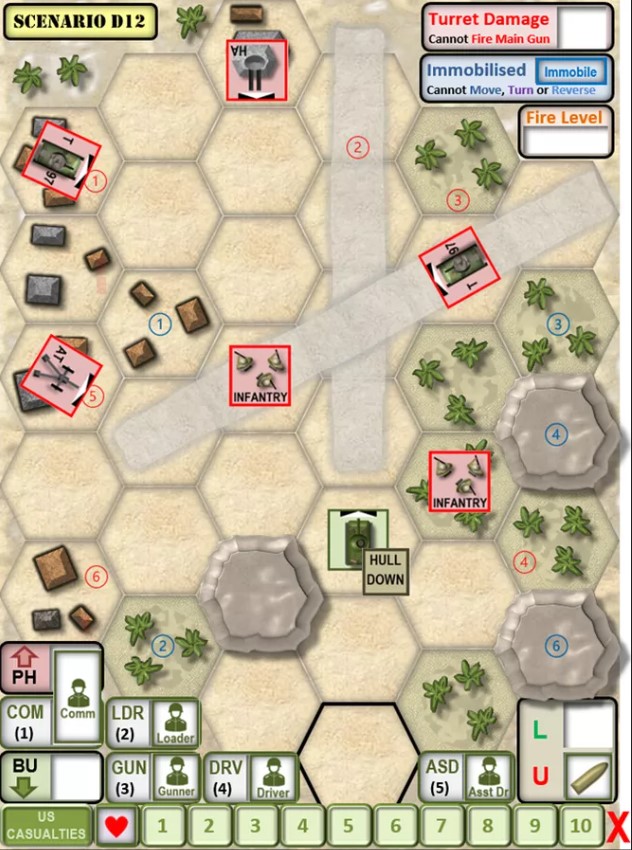Over the past several years, the solitaire tactical book wargame has gained a lot of traction in our hobby. A solitaire wargame that is fairly affordable at $20-$30 and can be purchased from on-line retailers like Amazon. What is not to like? And the name of Mike Lambo has been tied to a lot these games as he has designed 20+ of these titles and has built quite the rabid and loyal fanbase. Well, a few months ago, I decided that I was going to give his system a try and I purchased his newest game called Lone Sherman: The Pacific. I just had to find out what all the fuss was about. Now, I have looked into the book, and actually made some copies of the counters, but have yet to get up the gumption to do arts and crafts time to build the units so I can play. But, I am going to play it this year and share my thoughts on our channel. I also reached out to Mike to offer to do one of our designer interviews and he was more than willing to share.
Grant: First off Mike please tell us a little about yourself. What are your hobbies? What’s your day job?
Mike: Well I’m retired now but I was a university lecturer here in the UK for many years. I now enjoy travelling, walking and generally taking it easy. And designing wargames of course!
Grant: What motivated you to break into game design? What have you enjoyed most about the experience thus far?
Mike: To be honest, I’ve always enjoyed designing games, initially as a child and then for my own children when they were younger. It was only the ability to publish my own games in book format that enabled me to share some of my ideas with others. I will always enjoy the design process itself of course, but I cannot deny that I get a kick out of knowing that others enjoy my games too. I’m amazed how popular they have become.
Grant: Why has your Lone Series of games been so successful? What about the games has appealed to solo wargamers?
Mike: I’m not sure. I think games that allow players to use their imagination and create stories have always been popular, especially amongst wargamers. Lone Sherman allows an element of that but also retains the need for tactics and decision making, as well as being easy and relatively quick to play.

Grant: What is your upcoming game Lone Sherman: The Pacific about?
Mike: The game is a sequel to Lone Sherman and once again puts the player in control of a sole Sherman tank, this time taking place on several Pacific Islands in World War II. The game is about controlling that tank in order to survive and to complete scenario objectives whilst helping to protect your fellow American forces.
Grant: Why was this a subject that drew your interest?
Mike: I’ve always been interested in World War II, and whilst it has tended to be the European aspect of the war that has interested me the most in the past, I have recently become more intrigued by the Pacific Island invasions and the tactics used by both sides in those battles.
Grant: What is your design goal with the game?
Mike: The game follows my general design goals which are always to make a very playable game which is quick to set up and play but leaves the player feeling as though they have had a tough and engaging challenge which required them to make tactical decisions and other choices along the way.
Grant: What other designs inspired you in making this game?
Mike: I love D-Day at Tarawa form Decision Games which is the first Pacific based solitaire game I ever bought. I guess I was loosely influenced by other tank games such as Patton’s Best as well but Lone Sherman is very different from that game. The design itself is mostly based on a game I designed many years ago for my own use!
Grant: What elements from the Pacific Theater of Operations from WWII do you need to model in the design?
Mike: The key thing for me was to make this game different enough from Lone Sherman (which is based in Europe) and so I focused on the terrain and the Japanese forces and tactics. Whilst players of the original Lone Sherman will easily recognize the mechanics in this game, the feel is quite different as they battle against weaker Japanese tanks and more mobile and potentially lethal infantry charges.
Grant: As a solitaire game how does the AI function?
Mike: Generally, the player rolls a number of dice depending on the AI unit which is activating and then consults some (brief) charts to determine what that unit will do. Artillery units are fairly static and will try to fire at the Sherman where possible. Japanese tank units will often try to flank the Sherman and fire at it where possible. Infantry units will charge directly toward the Sherman with the intention of destroying it with mines and other anti-tank weapons.
Grant: What goals drive the AI?
Mike: That’s simple – to stop the player from achieving their objectives, preferably by destroying the Sherman! There main focus is that and the Japanese fanaticism really drives that part of the game. From banzai charges to other suicidal tactics.
Grant: What type of experience does it create?
Mike: I like to think it creates a pretty realistic experience in terms of not always having clear line of sight, not always being able to do exactly what you want to do, and facing the possibility of being hit at any time. Movement can also be frustrating, especially when trying to land on the beach from shallow water. Whilst straightforward, it tries to create a feeling of being confined in a tank which feels quite safe in some respects, being well-armed and well-armored, and yet very precarious in other respects.
Grant: How does the player have some degree of control over the level of risk they wish to take?
Mike: The player rolls dice to establish what actions they have available to them for the game turn. The number of dice depends on the terrain the tank is on and the crew members which are still alive. The player can mitigate risk by positioning the tank on ‘safer’ terrain, keeping the commander inside the tank, not moving too close to enemy lines of sight, trying to flank the enemy and taking note of the type of events that can occur at the end of each turn. In fact, there is an awful lot to think about, and it is easy to leave your tank more vulnerable than it needs to be, but practice makes perfect I guess!
Grant: How do Events come into the game? What do these Events represent?
Mike: Events occur at the end of a turn and are randomly generated by a die roll on a chart. They represent things over which the tank crew cannot have full control, although the player can mitigate this risk to a degree. Some of these Events only occur under certain circumstances, and the player can choose to ensure that these circumstances are not satisfied if they want to be more cautious.
Grant: Can you share with us some examples of these Events? Also how the effects can be mitigated?
Mike: Examples include enemy sniper and mortar fire, mechanical failure, enemy reinforcements and mines. In terms of mitigation, an example would be that the Commander cannot be hit by sniper fire if he is safely inside the tank.
Grant: How does the game include a mechanism to reflect US casualties in the theater?
Mike: Many of my games have turn counters to act as a timer. Lone Sherman did not have that, and neither does this sequel. However, the game does reflect the fact that there were obviously thousands of other US forces on the island which were the subject of horrific enemy fire. Each turn, the player rolls dice to determine the rate at which general US casualties increase. They are likely to increase more quickly if there are more enemy units on the map at the time. This gives the player an incentive to keep attacking, even when they may prefer to sit back and hide, because if those casualties get too high, the game ends in defeat.
Grant: How does the player prepare the book game for play?
Mike: The book includes a counter sheet as its final page which can be removed or downloaded from the files section of BoardGameGeek.com. It is relatively easy to stick this to medium card and cut out the counters. They can then be used directly on the maps included in the book, or again the maps can be downloaded from BoardGameGeek.com. Personally, I print the counters onto an A4 printer label, stick it to card and cut them up with scissors. I then open the book, pressing the spine down firmly to flatten it, and then use the counters on the maps in the book.

Grant: Where can they get advice on how best to do this?
Mike: People can see me make counters and play all my games on my YouTube channel – Mike Lambo Solitaire Book Games.
Grant: What is the makeup of the Japanese enemy units? What different type of units are represented?
Mike: There are heavy artillery units which are static and represent large guns in huge concrete bunkers. Whilst they can take out the Sherman if it moves in front of them, they are mainly there to cause general US casualties. Anti-tank artillery units do move and will turn to face the Sherman so are more dangerous in that respect. Japanese Type 95 and Type 97 tanks move around the map and whilst they are fairly weak, they can certainly cause serious damage if underestimated, especially against the Sherman’s weaker side and rear armor. Finally, infantry units with anti-tank weapons will only attack the Sherman when up close but if that is allowed to happen they can pack a real punch.
Grant: What crew members are represented in the game? What different abilities do they have?
Mike: The usual five Sherman crew members are present here. The Commander is in charge and can pop open the hatch if the player decides that is a good idea. He gives movement and attacking bonuses and also bonuses as one of the end of turn events. The Gunner and Loader provide attacking bonuses, including firing and loading the main gun and firing the machine guns (crucial to keep the Japanese infantry at bay). The Driver and Assistant Driver provide movement bonuses and machine gun bonuses too. It is fair to say that losing any crew member is a significant disadvantage.

Grant: If a crew member is KIA how does the player makeup for their absence?

Mike: Fortunately, losing a crew member will not generally mean that the tank cannot move or fire – it can still undertake its basic operation – it will simply be less efficient in doing so. Losing a crew member will often mean that the player will need to take more risks with popping their Commander out of the hatch to help with movement and attacking, something they will often rather not be doing.
Grant: How does the player make an attack?
Mike: Attacks consist of firing the main gun or firing the machine guns. The main gun must be loaded each time it is fired. Attacks are carried out by rolling dice with the target number being determined by several factors including the target unit and terrain features. Attacks using the main gun must hit and then cause damage. For attacks made against the Sherman it is also necessary to determine what type of damage has occurred.
Grant: What different types of damage can be taken?
Mike: The main damage caused to the Sherman is that it will be set on fire. This results in a ‘fire test’ each turn which can cause more damage or the destruction of the Sherman (and defeat for the player). The more fire damage the Sherman has, the more likely it will be destroyed. Fortunately the fire level can be reduced by the crew using an extinguish action. The tank can also be immobilized and the turret can be damaged (both of which can be repaired). In addition, crew members can be killed in action.

Grant: What is the general Sequence of Play?
Mike: There are seven phases to each turn. The player gets to decide where the Commander is going to be for the turn, either out of the hatch or inside the tank. The Sherman then gets to operate and the crew get to perform various actions. The fire check takes place then before the Japanese units get to activate, and general US casualties are determined, with the events occurring at the end of the turn.
Grant: How many different scenarios are included?
Mike: There are 12 scenarios with individually designed maps, enemy force compositions and objectives for each one.

Grant: How do they create a campaign?
Mike: The 12 scenarios are split into four sets of three and each of the four sets can be played as a campaign, with the player taking their Sherman onto the next scenario as they successfully complete each one, generally retaining the situation the tank is in, with some minor recovery opportunity between scenarios.
Grant: How do players achieve victory?
Mike: By completing the scenario objectives (or all three scenario objectives if playing a campaign). These usually involve clearing a map of enemies, or of a certain type of enemy, or simply finding a clear passage through the mayhem.
Grant: What do you feel the design excels at?
Mike: That feeling of having control over a Sherman and making things work and feeling relatively safe, until it all goes horribly wrong!
Grant: What other designs are you currently working on?
Mike: I’m always working on several designs at any given time. A couple are in the early stages but I do have a relatively advanced Eastern Front ‘Battles’ game which I hope will be ready for publication later this Spring.

Thank you so much for your time in answering my questions Mike. We very much appreciate it. I have purchased this game and will get it to the table soon and look forward to sharing my thoughts.
If you are interested in Lone Sherman: The Pacific, you can order a copy for $18.99 from Amazon at the following link: https://www.amazon.com/Lone-Sherman-Pacific-Solitaire-Wargame/dp/B0CY4WT5WH
-Grant

Great interview! I am VERY happy to see these games highlighted on your channel. I recommend the YouTube channel, it will help make an informed decision on what to start with, but I haven’t been disappointed with any of them. Also, Mike his HIGHLY underrated as a rules and editor. I haven’t found any issues with clarity or the slightest typo. That’s really saying something in todays environment.
LikeLiked by 1 person
Thanks Kyle. I have shot a playthrough and video review for Lone Sherman: The Pacific to start with. I will get a few more of his games but that is what I have done thus far. The videos won’t be up for a few months as we have a long queue.
LikeLike